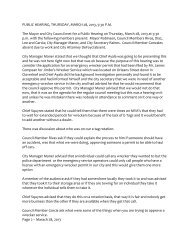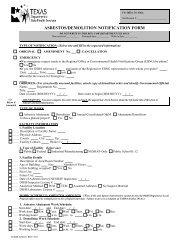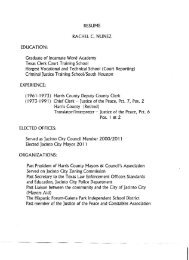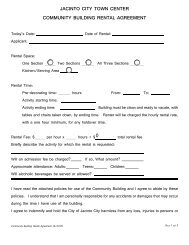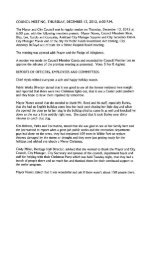demolition / renovation notification form instruction guide - Eng.hctx.net
demolition / renovation notification form instruction guide - Eng.hctx.net
demolition / renovation notification form instruction guide - Eng.hctx.net
You also want an ePaper? Increase the reach of your titles
YUMPU automatically turns print PDFs into web optimized ePapers that Google loves.
DEMOLITION / RENOVATION NOTIFICATION<br />
FORM INSTRUCTION GUIDE<br />
The Department of State Health Services Demolition/Renovation Notification <strong>form</strong> combines the requirements of the National<br />
Emission Standards for Hazardous Air Pollutants, 40 CFR, Subpart M (NESHAP) and the Texas Asbestos Health Protection<br />
Rules (TAHPR). Both of these regulations require that written <strong>notification</strong> be submitted before beginning <strong>renovation</strong> projects<br />
which include the disturbance of any asbestos-containing building material in a public building or the disturbance of the<br />
NESHAP threshold amount of asbestos-containing material in a facility. A <strong>notification</strong> <strong>form</strong> is required before the <strong>demolition</strong><br />
of a building or facility, even when no asbestos is present. This <strong>form</strong> must be used to fulfill either of these requirements.<br />
Please call either 512-834-6747 or 1-888-778-9440 (within Texas), or your local regional office for assistance in completing<br />
this <strong>form</strong>.<br />
This <strong>form</strong> must be used whether you are notifying in accordance with NESHAP, TAHPR, or both. The <strong>notification</strong> <strong>form</strong> must<br />
be postmarked at least 10 working days (not calendar days) prior to the project start date (except for emergencies or ordered<br />
<strong>demolition</strong>s). Notifications that do not meet the 10-day requirement or are incomplete are considered to be "improper" and<br />
may result in enforcement proceedings. If an item on the <strong>form</strong> is not applicable to the project in question, you must write<br />
"N.A." in that space, which shows that you have considered the item, but it does not apply to your operation.<br />
INSTRUCTIONS<br />
I) The <strong>notification</strong> type must be checked. An original must be postmarked 10 working days (Mon. - Fri.) prior to the<br />
start date. An amendment is required for any stop date, which changes by more than one working day for each week<br />
for which the project has been scheduled. An amendment must be submitted for any changes from the original<br />
<strong>notification</strong> and must be provided to DSHS no less than 24 hours prior to the change, including stop date changes.<br />
Please note these changes by circling or highlighting them on the <strong>form</strong>. Attach a copy of the original <strong>notification</strong> or<br />
previous amendment to the back of the amendment (Example: If you are sending in Amendment 2 attach a copy of<br />
Amendment 1 behind it. When marking which Amendment you are sending in, do not count the Original <strong>notification</strong><br />
as Amendment 1.The start date can be any day after the 10th working day and must be specified in Section IV. A<br />
cancellation must be postmarked 24 hours or more prior to the scheduled start date. If asbestos abatement or<br />
<strong>demolition</strong> will begin earlier than scheduled, an amendment must be postmarked at least 10 working days prior to the<br />
new start date. If the start date is to be delayed, the amendment must be postmarked 24 hours prior to the scheduled<br />
original start date. The appropriate DSHS Regional or Local Program inspector must be notified by phone of all<br />
start or stop date changes.<br />
The appropriate DSHS Regional or Local Program inspector should be contacted in the event of an emergency. All<br />
in<strong>form</strong>ation regarding an emergency must be provided. Emergency <strong>notification</strong>s must be postmarked no later than the<br />
following working day after the emergency incident.<br />
If the <strong>demolition</strong> is ordered, then all in<strong>form</strong>ation in this section must be provided. The appropriate DSHS Regional or<br />
Local Program inspector should be notified, by telephone or in person, prior to beginning the ordered <strong>demolition</strong>.<br />
Notifications for ordered <strong>demolition</strong> must be postmarked as soon as practicable, but no later than the following<br />
working day after the <strong>demolition</strong>. A copy of the <strong>demolition</strong> order must be submitted with the <strong>notification</strong>.<br />
II)<br />
One type of work must be checked. An asbestos-related activity (asbestos abatement project) is marked as a<br />
<strong>renovation</strong>. A project that includes the removal of load-bearing structural members is marked as a <strong>demolition</strong>. If the<br />
project involves both a <strong>renovation</strong> and <strong>demolition</strong> portion check the one which will be occurring last as far as project<br />
dates are concerned. An annual consolidated <strong>notification</strong> can be submitted for a calendar year of January 1 through<br />
December 31. The annual consolidated <strong>notification</strong> will predict all asbestos O&M operations and all small, separate<br />
abatement projects that are less than 160 square feet, 260 linear feet or 35 cubic feet. The predicted, additive amount<br />
of asbestos to be removed or stripped during the one-year period must be listed in the chart in Section V.<br />
A phased project classification can be added to the type of work; it cannot be marked alone. (The project may be a<br />
1
phased <strong>renovation</strong> or a phased <strong>demolition</strong> - the phased box AND either the <strong>renovation</strong> box or <strong>demolition</strong> box must be<br />
checked). A description of the phased project schedule must be sent to the appropriate DSHS or Local Program<br />
inspector. The DSHS policy regarding phased projects must be strictly followed, if that box is checked. (A copy of<br />
the phased project policy letter can be obtained by calling any DSHS inspector). The scheduled work time must be<br />
checked. A description of the work schedule must be provided, if the schedule varies from that listed as the project<br />
dates (Section 16 and/or Section 17). Example: If a project is scheduled to last one month, but the contractor will not<br />
be working on the weekends, a statement should be included that say “Working Monday - Friday.” The statement<br />
must be accurate; an inspection will be based upon the provided in<strong>form</strong>ation.<br />
III)<br />
Provide the name of the building or an identifying description. Example: vacant warehouse. A physical address must<br />
be provided (not a post office box) and a sufficient description must be provided to locate the site in the event that the<br />
address alone is inadequate. The ZIP CODE for the building MUST be provided. The name of a contact person at<br />
the facility MUST be provided for inspection purposes, even if the building or facility is vacant. If the building does<br />
not have a phone, list the contact person’s phone number.<br />
The type of building/facility must be checked. Only one box may be checked. An example of a NESHAP-Only<br />
Facility would be a house that was being demolished as part of a Texas Department of Transportation right-of-way<br />
project, or a ship.<br />
Detailed in<strong>form</strong>ation must be provided in all spaces, including the age and size of the building or facility. Check<br />
whether the building/facility is occupied. If the building/facility is vacant during the time of the <strong>renovation</strong>, but will<br />
later be re-occupied (not demolished), then indicate that the building/facility is occupied.<br />
An asbestos survey/inspection must be per<strong>form</strong>ed prior to any <strong>renovation</strong> or <strong>demolition</strong>. A DSHS licensed inspector<br />
must per<strong>form</strong> the inspection if the project is in a public building. Provide the DSHS Inspector License Number, if<br />
required. If the survey/inspection was per<strong>form</strong>ed in a public building prior to January 1993, or if the project is not in a<br />
public building, "N.A." should be placed in the space for the DSHS License Number. The date that the survey was<br />
per<strong>form</strong>ed must be provided. The analytical method used to detect the presence of asbestos must be checked. TAHPR<br />
requires that a DSHS licensed laboratory per<strong>form</strong> the analysis of samples from public buildings. Provide the DSHS<br />
Laboratory Number if the samples are collected from a public building. The assumption of asbestos-containing<br />
building material (for <strong>renovation</strong>s) in a public building must be made by a DSHS licensed inspector. The date that the<br />
survey (assessment) was per<strong>form</strong>ed would be provided, the DSHS Inspector License Number would be provided, and<br />
the “assumed” analytical method box would be checked on the <strong>notification</strong> <strong>form</strong>, for an assumption of any asbestoscontaining<br />
materials that would be abated during a <strong>renovation</strong> project. When an assumption of asbestos-containing<br />
material is done in a non-public building, all of the above must be completed except for the DSHS Inspector and<br />
Laboratory License Numbers (not required). If there was no suspect material discovered, such as a garage, built of<br />
concrete and steel only, indicate that no suspect material was found.<br />
IV)<br />
If ACBM is to be removed before a building is to be demolished or renovated, enter the removal dates (start and<br />
completion) in this section. Asbestos abatement work includes any activity which will disturb ACBM. The asbestos<br />
abatement start date is the date that asbestos will be disturbed. The asbestos abatement activity stop date is the date<br />
upon which air monitoring clearance has been achieved. In no event shall an abatement start or be completed on a<br />
date other than the dates entered in this section (see Section 295.61(f)). Refer to Section I for in<strong>form</strong>ation on<br />
notifying of any change in the start and completion dates.<br />
Enter the scheduled dates for the start and completion of the building <strong>demolition</strong>. In no event shall a <strong>demolition</strong><br />
start or be completed on a date other than the dates entered in this section. Refer to Section I for in<strong>form</strong>ation on<br />
notifying of any changes in the start or completion dates. When the building will not be demolished, but an abatement<br />
will be per<strong>form</strong>ed, the dates of the total <strong>renovation</strong> (remodeling) project can be provided in this section. The<br />
<strong>notification</strong> will remain active, if the <strong>renovation</strong> dates are provided.<br />
V) If asbestos is present, the chart must be completed. If no asbestos is present (as revealed by the survey), check the box<br />
provided. Category I non-friable ACBM includes floor tile, when removed intact, floor tile mastic, gaskets, and<br />
roofing material. Category II non-friable ACBM includes transite siding. Use the appropriate row to designate<br />
whether the “Category I or Category II non-friable ACBM removed” is located on the interior or exterior of the<br />
2
uilding. If Category I or II materials are to be sanded, ground, abraded, crumbled, pulverized, reduced to powder, or<br />
have the potential to become friable because of the abatement procedures, then list them with RACM. “ Category I<br />
and II left in place during <strong>demolition</strong>” would be listed for <strong>demolition</strong>s or for enclosure or encapsulation. (Transite<br />
does not remain Category II during <strong>demolition</strong> and must be removed prior to <strong>demolition</strong>). “RACM left in place during<br />
<strong>demolition</strong>” would be listed for enclosure or encapsulation or in the event of a <strong>demolition</strong> under very specific<br />
conditions (such as the <strong>demolition</strong> of a structurally unsound building). RACM Off-Facility Component (material that<br />
is not attached to the facility) shall only be measured in cubic feet or cubic meters. All other material must be<br />
measured in linear feet or meters (pipes) or in square feet or meters (surface material). If an abatement will be<br />
per<strong>form</strong>ed in a portico, or a HVAC system that conditions the inside of a public building, list the amount as “Interior<br />
Category I non-friable removed, Interior Category II non-friable removed, or RACM to be removed”, depending on<br />
the type of ACBM that will be removed. The amounts listed should always reflect the TOTAL amount removed<br />
during the project.<br />
VI)<br />
Provide adequate in<strong>form</strong>ation to demonstrate that appropriate actions have been considered and can be implemented to<br />
control asbestos emissions adequately, including con<strong>form</strong>ance with applicable work practice standards. This section<br />
must be completed, even if no asbestos was discovered in the survey. Example: stop work; contact<br />
owner/consultant and DSHS; demarcate area; secure critical barriers.<br />
Include in this section the <strong>demolition</strong> and <strong>renovation</strong> techniques to be used and a description of the areas and types of<br />
facility components, which will be affected by this work. The specific type of asbestos-containing building material<br />
that will be abated must be listed. Example: Vinyl asbestos-containing floor tiles to be removed by wet methods<br />
recommended by the Resilient Floor Covering Institute.<br />
Describe the work practices and engineering controls selected to ensure compliance with the requirements of the<br />
regulations, including both the asbestos removal and waste-handling emission control techniques. Example: describe<br />
a glove-bag procedure, including the use of a HEPA vacuum. Work practices that vary from the provisions of<br />
TAHPR, §295.60 must be clearly described in this section.<br />
VII) A. Provide in<strong>form</strong>ation on the legal owner of the facility. The invoice for the <strong>notification</strong> fee will be sent to the<br />
owner of the building, and the billing address for the invoice will be obtained from the in<strong>form</strong>ation that is<br />
provided in this section. The company's name should be written on the first line. A specific person's name<br />
should be written following "Attention..." on the third line. This person will be receiving the <strong>notification</strong> fee<br />
in<strong>form</strong>ation.<br />
B. The Department of State Health Services (DSHS) Contractor License Number is required if the project falls<br />
under TAHPR. The contractor's name, address, and office phone number must be provided. The contractor’s<br />
address must match that which was submitted on the DSHS license application, if the company has more than<br />
one office.<br />
C. In the event that two asbestos abatement contractors are used, provide all in<strong>form</strong>ation for the second<br />
contractor in the space provided. For a <strong>demolition</strong> in which the building does not contain asbestos, or in<br />
which the non-friable asbestos will not be removed prior to <strong>demolition</strong>, write "N.A." in the spaces provided<br />
for the abatement contractor in<strong>form</strong>ation.<br />
D. The site supervisor must be stated and the DSHS Supervisor License Number is only required for public<br />
building projects as defined in TAHPR. Two site supervisors may be listed, if there are two work shifts, etc<br />
E. The trained on-site NESHAP individual and the certification date must be stated for NESHAP projects. The<br />
site supervisor and the trained on-site NESHAP individual may be the same person, if qualified. List the<br />
individual’s name in both spaces. Since the DSHS License satisfies the requirements for NESHAP training,<br />
provide the supervisor’s name and DSHS License Number and write "N.A." in the spaces for the NESHAP<br />
individual and certification date.<br />
F. The <strong>demolition</strong> contractor's name, address, and office phone number must be provided for all <strong>demolition</strong><br />
projects.<br />
3
G. A DSHS licensed asbestos project consultant is required to design all asbestos response actions in public<br />
buildings. A DSHS licensed asbestos project consultant is also required to design all asbestos abatement<br />
projects which involve non-friable asbestos-containing building materials in quantities greater than 160<br />
square feet, 260 linear feet, or 35 cubic feet, in accordance with TAHPR. Provide all other in<strong>form</strong>ation. The<br />
consultant’s address must match that which was submitted on the DSHS license application, if the company<br />
has more than one office. If the project is not in a public building, the general contractor, or any other person<br />
who controls the project site, may be listed as the "operator.”<br />
H. Provide all in<strong>form</strong>ation for the waste transporter. The TAHPR requires that a DSHS Licensed Transporter<br />
transport ACBM from the public building removal site to the waste disposal site. Provide the license number<br />
if the project is a public building. If you are per<strong>form</strong>ing a <strong>demolition</strong> without ACBM you still need to list<br />
who will be transporting the waste from the project site. If two waste transporters are utilized, one to<br />
transport to a holding site and one to transport from the holding site to the waste disposal site, list the first<br />
transporter on the <strong>notification</strong>. However, the waste manifest must contain in<strong>form</strong>ation for both transporters.<br />
I. Provide all in<strong>form</strong>ation for the waste disposal site. State regulations require that all waste disposal sites be<br />
permitted by the Texas Commission on Environmental Quality (TCEQ), including disposal sites located at<br />
industrial facilities. Provide the permit number.<br />
An amendment must be submitted if any of these items are changed.<br />
VIII)<br />
The <strong>notification</strong> for the abatement in a public building shall only be signed by the legal owner, his designated legal<br />
representative, the DSHS licensed abatement contractor, or the DSHS licensed consultant. The TAHPR allows for<br />
this task to be delegated to the DSHS licensed contractor or the DSHS licensed consultant IN WRITING; however,<br />
the responsibility continues to be shared with the owner. For a NESHAP abatement or <strong>demolition</strong>, the <strong>notification</strong><br />
<strong>form</strong> may be signed by the legal owner or the operator of the site. The name must also be printed, and the date and<br />
telephone number must be provided. The signature must be an original; a copied signature will not be accepted.<br />
Please Sign in blue or red ink to avoid confusion.<br />
MAIL TO:<br />
ENVIRONMENTAL HEALTH NOTIFICATIONS GROUP<br />
DEPARTMENT OF STATE HEALTH SERVICES<br />
PO BOX 143538<br />
AUSTIN, TEXAS 78714-3538<br />
An invoice for the <strong>notification</strong> fee will be sent to the facility owner (c/o the person identified in Section VII, A) after the<br />
project has been completed. DO NOT submit the fee with the <strong>notification</strong>. Revised 6/01/2007<br />
4



